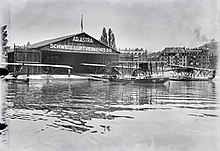Zürichhorn



Zürichhorn is a river delta on Zürichsee's eastern shore in the lower basin of the lake. The area is part of the parks and quays in the Seefeld quarter of the city of Zürich in Switzerland. The gardens are one of the most popular recreational areas within the city of Zürich.
Geography
Zürichorn was formed mainly by the Hornbach stream, also known as Wildbach and Werenbach, which flows, as of today embedded into a concrete canal, between Tiefenbrunnen lido and the landing gate of the Zürichsee-Schifffahrtsgesellschaft (ZSG) into Lake Zürich. Ending the last glacial period when the Linth glacier retreated, the Wehrenbach stream dug over through the Linth glacier's moraine, met the rocky ground, the so-called molasse, and by its attachment the river delta at the Zürichhorn respectively the Seefeld quarter was formed.
Transportation
Zürichhorn can be reached preferably by foot (20 minutes from Bellevue) or by public transportation: Zürich tram routes 2 and 4 and bus line 33 to stops Höschgasse or Fröhlichstrasse, or bus lines 912 and 916 from Bellevue to Chinagarten. During summer season, three Limmat boats provide round trips between Landesmuseum–Wollishofen–Zürichhorn-Landesmuseum on the Limmat river through the city of Zürich respectively Zürichhorn is a stop of the roundtrips on Lake Zürich provided by Zürichsee-Schiffahrtsgesellschaft (ZSG).[1]
History
In 1238 «Otinbach» stream is first mentioned, which can be derived from «Otto's stream» respectively Old High German «ôt» meaning «heritage». The then used name Oetenbach may refer to the river on whose banks an estate, fishing or other rights were situated.[2] About the same time, at Zürichhorn was the Oetenbach monastery established, lacking experience on swampy ground; therefore around 1280/85 the Dominican sisters of the convent moved to Sihlbühl at Lindenhof hill within the fortifications of the city of Zürich.

In the 16/17th century, rich Zürich citizens built their country seats outside the town walls of the city of Zürich on lakeshore in the Seefeld quarter. In the 1840s several construction companies settled around Zürichhorn: Raw material was delivered on the lake respectively shore-based on (as of today) Fröhlichstrasse. The then Hornegg was developed until the end of the 19th century as the local center of construction and ship building companies. In 1894 the railway line Rechtsufrige Zürichseebahn was established, since then most of the companies moved to the more attractive Industriequartier in the western parts of the city of Zürich.[3]
1879/81 the Wildbach river has been corrected to avoid recurrent floodings of the former municipality of Riesbach (as of today Zürich's district number 8). The stream was discharged to the south of Lake Zürich, and from then, is was called Hornbach nearby its mouth. Opening the Lake Zürich quais, in 1887 the park area was expanded from Seefeld-Quai to Zürichhorn, in order to promote «companionship, recreation and amusement». A spacious park landscape was built by the landscape architects Otto Froebel and Evariste Mertens.[4]
Water airport Zürichhorn


In summer 1910 Wagenfabrik C. & R. Geissberger provided first test flights with so-called Hydroplanes (flying boats) at Zürichhorn. Initiated by Oskar Bider and Fritz Rihner, in July 1919 the «Schweizerische Gesellschaft für Lufttourismus» was established in Zürich. Touristical flights with flying boats were planned from sites at Zürichhorn, in Geneva, Interlaken/Thun, Locarno, Lugano, Lucerne, Lausanne-Ouchy, Romanshorn and St. Moritz. Switzerland, with its numerous lakes, appeared predestined for the use of seaplanes, so that no expensive airports had to been built. Oskar Bider was killed in an anccident before the ambitious project was realized, but from Zürichhorn respectively (as of today) the area of the Strandbad Tiefenbrunnen (lido) the Swiss airline Ad Astra Aero operated with seaplanes, among them seven Macchi-Nieuport and five Savoia flying boats and the first large flying boat, Dornier Wal.[3]
Sights
Sights include the spacious parks and quais with various sculptures including Jean Tinguely's Heureka, Chinagarten Zürich at Blatterwiese and in the northeast the last by Le Corbusier designed building, now Heidi-Weber-Museum respectively Centre Le Corbusier. On the southeastern side of the delta is the Strandbad Tiefenbrunnen located. The Restaurant Fischstube was built as part of the Swiss national exhibition 1939, it acclaims to be the only house within the city of Zürich with a thatched roof.[5][6]
Among the many major events at Zürichhorn are the Schweizerische Landesausstellung 1939 (Swiss national exposition), Schweizerische Gartenbauausstellung G59 in 1959, and in 1991 the national research exhibition Heureka. Since 1989, Kino am See (cinema on lake), the largest open-air cinema in Switzerland, will take place between mid-July and mid-August at Zürichhorn on Lake Zürich shore.
The lakeside parks are annually frequented by 2.5 million visitors.[4] Zürichhorn and Seefeld-Quai are listed as Swiss heritage sites of national significance.
Gallery
-
Jean Tinguely's Heureka
-
Kugelbrunnen, a relict of the Phenomena exhibition of 1984
-
Alopochen aegyptiacus at Zürichhorn
-
Restaurant Fischstube
-
Casino Lake Side Zürichhorn
-
Tiefenbrunnen lido
-
ZSG Paddle steamer Stadt Zürich at Zürichhorn landing gate
-
Zürichhorn landing gate
External links
References
- ^ Zürichsee-Schiffahrtsgesellschaft (ZSG): Fleet
- ^ Website Cicerone Performance: Die Oetenbachgasse in der minderen Stadt
- ^ a b Website Gang dur Alt-Zürich: Das Zürichhorn und die Zivilaviatik
- ^ a b Official website of the city of Zürich (Grün Stadt Zürich): Zürichhorn
- ^ Website Restaurant Fischstube
- ^ Tages Anzeiger (January 29, 2010): Die Fischstube am Zürichhorn wird im alten Stil neu gebaut










